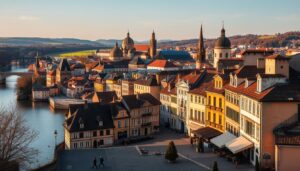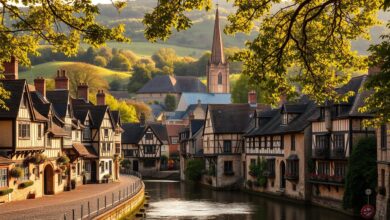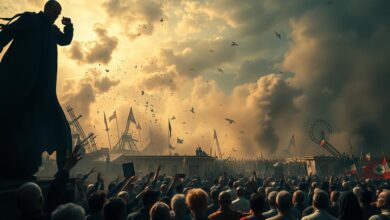Poland: Uncover the Beauty and Charm of This European Gem
Welcome to a captivating European destination that promises an unforgettable experience. As you explore this beautiful country, you’ll discover a rich heritage and stunning landscapes that will leave you enchanted.

From the snow-capped Tatra Mountains to the bustling streets of Warsaw, this European gem is a treasure trove of history, art, and natural beauty. You’ll uncover hidden gems and must-visit attractions as you journey through the heart of this captivating country.
Key Takeaways
- Discover Poland’s rich heritage and cultural landmarks
- Explore the stunning landscapes and natural beauty
- Visit the historic city of Warsaw and its bustling streets
- Enjoy the breathtaking scenery of the Tatra Mountains
- Experience the vibrant culture and art scene
Discovering Poland: A Land of Rich Heritage and Natural Beauty
When you arrive in Poland, you’ll find a wealth of history, culture, and stunning landscapes. This European treasure mixes old and new, appealing to all kinds of travelers.
What Makes Poland a Must-Visit European Destination
Poland’s deep history draws many visitors. Its Polish history shines through in medieval towns, Renaissance buildings, and historical sites. You can explore Krakow’s Old Town, see the Royal Castle in Warsaw, or visit Gdansk’s historic sites. Each place offers a peek into Poland’s rich past.
The Polish culture is also a big attraction. It’s known for lively folk traditions, tasty food, and friendly people. Poland’s cultural scene is full of life, from folk dances to modern art.
Geographic Diversity: From Baltic Shores to Mountain Peaks
Poland’s geographic diversity is truly impressive. It has everything from Baltic Sea beaches to the Tatra Mountains’ snowy peaks. Nature fans can hike, ski, or just enjoy the views.
The Masurian Lake District is a haven for water sports and peace. It’s called the “Land of a Thousand Lakes.” Whether you love outdoor adventures or peaceful settings, Poland’s varied landscapes have something for everyone.
“Poland is a country where the past and present blend together in a unique and fascinating way, giving visitors an unforgettable experience.”
A Journey Through Polish History: From Medieval Kingdom to Modern Nation
Poland’s history is a mix of triumph and tragedy. Exploring this rich heritage shows how different times have shaped the nation. Today’s Poland is a result of these periods.
The Rise and Fall of the Polish-Lithuanian Commonwealth
In the 16th century, Poland was at its peak as part of the Polish-Lithuanian Commonwealth. This vast empire went from the Baltic Sea to the Black Sea. It was a time of great cultural and economic growth.
But, the Commonwealth started to decline in the 17th century. This was due to internal conflicts and external pressures. Eventually, it was divided by its neighbors in the late 18th century.
World War II’s Profound Impact on Poland
The 20th century brought great devastation to Poland during World War II. The country suffered under Nazi occupation, losing many lives and cultural treasures. Cities like Warsaw were destroyed.
After the war, Warsaw was rebuilt. Today, many museums and memorials across Poland remember this period.
Poland’s Path to Democracy and EU Membership
In the late 20th century, Poland moved from communism to democracy. This journey ended with its joining the European Union in 2004. This change has deeply influenced Poland’s economy, politics, and culture.
| Historical Period | Key Events | Significance |
|---|---|---|
| Polish-Lithuanian Commonwealth (16th-18th century) | Formation of a vast empire, cultural achievements | Peak of Poland’s power and cultural influence |
| World War II (1939-1945) | Nazi occupation, destruction of cities, loss of life | Significant human and cultural loss, rebuilding efforts post-war |
| Transition to Democracy (late 20th century) | Shift from communism to democracy, EU membership | Integration into the European community, economic and political reforms |
Visiting cities like Krakow and Warsaw in Poland offers a deeper look at these events. You’ll understand their lasting effects on the nation.
Warsaw: The Phoenix City That Rose From the Ashes
Warsaw, Poland’s capital, has come back stronger than ever. It mixes old history with new modern touches. After World War II, the city was rebuilt, and its Old Town was carefully restored. Now, Warsaw is a lively city, combining its past with today’s architecture and culture.
Old Town: A UNESCO World Heritage Masterpiece of Reconstruction
Warsaw’s Old Town shows the city’s strength and will to survive. It was rebuilt stone by stone, with colorful buildings and old streets. As a UNESCO World Heritage site, it’s a key place to see Poland’s history.
Modern Warsaw: Business Hub and Cultural Center
Modern Warsaw is a different story. It’s a busy center for business and culture. The city is home to many multinational corporations and startups. It also has a vibrant cultural scene with museums, galleries, and theaters.
Must-Visit Museums and Landmarks in Poland’s Capital
Warsaw has many museums and landmarks that show its history and culture. Some top spots include:
The Royal Castle and Palace of Culture and Science
The Royal Castle was once home to Polish kings. The Palace of Culture and Science is a unique Stalinist building with great city views.
Warsaw Uprising Museum and POLIN Museum
The Warsaw Uprising Museum shares the city’s WWII bravery. The POLIN Museum focuses on Polish Jews, giving visitors a deep and moving experience.
| Attraction | Description |
|---|---|
| Royal Castle | Majestic fortress that served as the residence of Polish kings |
| Palace of Culture and Science | Striking example of Stalinist architecture with panoramic views |
| Warsaw Uprising Museum | Story of the city’s brave resistance during World War II |
| POLIN Museum | History of Polish Jews |
Krakow: Poland’s Cultural Heart and Medieval Treasure
When you arrive in Krakow, you enter a world filled with medieval charm. This ancient city is a treasure trove of Polish culture. It boasts stunning architecture, a rich history, and a vibrant cultural scene.
Wawel Castle and Cathedral: The Royal Residence
Wawel Castle is a must-see in Krakow. It’s a magnificent structure that has stood the test of time. The adjacent cathedral, with its stunning Gothic architecture, is a place of great historical significance. It was the coronation site of many Polish kings.
As you explore the castle and cathedral, you’ll be surrounded by centuries of history and cultural heritage.
Exploring Europe’s Largest Medieval Market Square
The Main Market Square, or Rynek Główny, is a bustling hub of activity. It’s surrounded by historic buildings, cafes, and shops. At its center stands the iconic Cloth Hall, a testament to Krakow’s rich trading history.
As you wander through the square, you’ll be struck by its grandeur and the lively atmosphere that pervades it.
“Krakow’s Main Market Square is a true marvel, a place where history and culture come alive.”
Day Trips from Krakow: Wieliczka Salt Mine and Auschwitz-Birkenau
Just outside Krakow lie two significant historical sites that are easily accessible on a day trip. The Wieliczka Salt Mine, a UNESCO World Heritage Site, offers a fascinating glimpse into the region’s industrial past. Auschwitz-Birkenau, a somber reminder of the atrocities committed during World War II, is a poignant and thought-provoking experience.
Both sites provide a deeper understanding of Poland’s complex history and its impact on the world today.
Beyond the Major Cities: Poland’s Hidden Gems
Poland has more than just Warsaw and Krakow. Its diverse regions are full of hidden gems. Exploring these places lets you see Poland’s true charm.
Gdańsk and the Tri-City Area: Baltic Sea Splendor
Gdańsk, Sopot, and Gdynia make up the Tri-City area. They offer a mix of maritime history, culture, and stunning Baltic Sea views. You can walk the historic Long Market in Gdańsk, see the European Solidarity Centre, or relax on Sopot and Gdynia’s beaches.
Wrocław: The City of 100 Bridges
Wrocław is famous for its many bridges, canals, and islands. Don’t miss the Panorama of Racławice or the Ostrów Tumski (Cathedral Island) with its Gothic architecture.
Zakopane and the Tatra Mountains: Poland’s Alpine Paradise
Zakopane is perfect for mountain lovers. It’s at the Tatra Mountains’ foot, great for hiking, skiing, and scenic views. Try a cable car ride to Kasprowy Wierch or see Zakopane’s wooden houses.
These spots show Poland’s varied regions and experiences. They’re great Poland travel tips for your next visit.
Tourist Attractions in Poland That Shouldn’t Be Missed
Exploring Poland reveals a rich mix of attractions. You’ll find stunning landscapes, deep history, and unique cultural experiences. There’s something for every traveler.
Natural Wonders: Białowieża Forest and Masurian Lake District
Poland boasts some of Europe’s most stunning natural wonders. The Białowieża Forest, a UNESCO site, is a remnant of Europe’s ancient forests. It’s home to European bison and diverse wildlife.
The Masurian Lake District offers breathtaking views and outdoor fun. Activities include sailing, kayaking, and hiking.

Historical Sites: Malbork Castle and Wolf’s Lair
Poland’s history shines through its sites, like Malbork Castle. It’s the world’s largest brick castle and a UNESCO site. The Wolf’s Lair, Hitler’s WWII headquarters, is another must-see.
| Historical Site | Location | Significance |
|---|---|---|
| Malbork Castle | Malbork | Largest brick castle in the world |
| Wolf’s Lair | Kętrzyn | Former headquarters of Adolf Hitler |
Unique Experiences: Wooden Churches and Underground Routes
Poland offers unique cultural experiences. You can explore wooden churches in southern Poland. They show traditional craftsmanship and the country’s religious past.
The Wooden Churches of Southern Poland
These churches, from the 17th and 18th centuries, feature stunning wooden architecture. Their interiors are ornate and beautiful.
Underground Tourist Routes in Rzeszów and Sandomierz
For a unique experience, visit underground routes in Rzeszów and Sandomierz. They reveal Poland’s hidden history.
Immersing Yourself in Polish Culture and Traditions
Polish culture is full of folk festivals and artistic wonders. As you explore Poland, you’ll find a rich heritage. It’s both captivating and deeply rooted in history.
Folk Traditions and Festivals Throughout the Year
Poland’s folk traditions are vibrant, with many festivals celebrating music, dance, and crafts. The International Folk Dance Festival in Kraków is a highlight. It brings together dancers from all over to show their traditional moves.
Polish Art, Music, and Literary Heritage
Polish culture is famous for its arts. The country has given the world great composers like Chopin and Paderewski. Their music is loved worldwide. Polish literature is also rich, thanks to authors like Wisława Szymborska and Czesław Miłosz, who won Nobel Prizes.
“Poland’s cultural identity is a mosaic of its history, folklore, and artistic achievements.”
Religious Traditions and Their Cultural Significance
Religion is key in Polish culture, with most people being Roman Catholic. Religious traditions are part of everyday life and cultural practices. They shape festivals, customs, and community events.
| Cultural Aspect | Description | Significance |
|---|---|---|
| Folk Traditions | Festivals and dances passed down through generations | Preserves cultural heritage |
| Artistic Contributions | Music, literature, and visual arts | Enhances Poland’s cultural identity |
| Religious Practices | Influences daily life and cultural events | Shapes community and traditions |
Savoring Polish Cuisine: Beyond Pierogi and Kielbasa
Polish food is more than just pierogi and kielbasa. It’s a world of flavors shaped by history and geography. Exploring local cuisine reveals a rich heritage.
Traditional Polish Dishes You Must Try
Polish dishes are known for their hearty soups and main courses. Here are some dishes you should try:
Soups: Żurek, Barszcz, and Flaki
Polish soups are a big part of their cuisine. Żurek, a sour rye soup, is a favorite. Barszcz, or beetroot soup, is also popular, often served with pierogi or pastry. Flaki, or tripe soup, is a comforting choice.
Main Courses: Bigos, Gołąbki, and Kotlet Schabowy
For main courses, Bigos, a hunter’s stew, is a must-try. Gołąbki, or cabbage rolls, are another tasty option. Kotlet Schabowy, a breaded pork cutlet, is a Polish twist on a classic.
Regional Specialties from Different Parts of Poland
Poland’s regions have their own special dishes. For example, the Podhale region is known for Oscypek, a smoked sheep’s milk cheese. The Masurian region is famous for its fish dishes, like eel and pike.

Polish Vodka and Other Local Beverages
Polish vodka is a must-mention in any discussion of Polish cuisine. It has a long history and is known for its quality. Other local drinks include kompot, a fruit drink, and piwo, or beer, brewed in various regions.
Best Times to Visit Poland: Seasonal Highlights and Events
Planning your trip to Poland? Knowing the best times to visit can make your trip better. Poland is great all year, with each season bringing its own charm.
Summer in Poland: Festivals, Outdoor Activities, and Crowded Attractions
Summer is the busiest time in Poland, with great weather for outdoor fun. You can hike in the Tatra Mountains or sail on the Masurian Lakes. The Open’er Festival in Gdynia is a big draw for music fans. But, popular spots can get really crowded, so plan carefully.
Spring and Fall: Ideal Seasons for Comfortable Exploration
Spring and fall are the best times to see Poland’s cities and countryside. The weather is mild, and there are fewer people around. Spring brings beautiful blooms at Warsaw’s Royal Castle, and fall offers stunning views in Białowieża Forest. These seasons are perfect for visiting historical sites without the summer rush.
Winter Magic: Christmas Markets and Snow-Covered Landscapes
Winter turns Poland into a magical place, with snow and Christmas markets. Zakopane is a top spot for winter sports, and Krakow’s Main Market Square has a lovely Christmas market. It’s also a great time to try traditional Polish food and enjoy the warm welcome.
| Season | Highlights | Activities |
|---|---|---|
| Summer | Festivals, warm weather | Hiking, sailing, Open’er Festival |
| Spring/Fall | Mild temperatures, fewer tourists | City exploration, historical sites, hiking |
| Winter | Snow-covered landscapes, Christmas markets | Skiing, traditional cuisine, Christmas markets |
Conclusion: Why Poland Deserves a Spot on Your Travel Bucket List
When thinking about your next travel spot, Poland is worth considering. It offers a mix of history, culture, and stunning landscapes. Poland promises an experience you won’t forget.
In Krakow, walk through historic streets and see the Wawel Castle. Warsaw’s Old Town is also a must-see. Poland’s geography is diverse, with the Baltic Sea, Tatra Mountains, and Masurian Lake District. It’s great for both outdoor lovers and history fans.
Poland is a unique blend of old and new. It’s known for its festivals, food, and friendly people. If you’re curious about its beauty and charm, start planning your trip. Discover all that this amazing European country has to offer.
FAQ
What is the best time to visit Poland?
Poland welcomes visitors all year. Summer is great for outdoor fun and festivals. Spring and fall are perfect for exploring with comfortable weather. Winter is ideal for Christmas markets and snowy views.
What are the must-try Polish dishes?
You must try pierogi, bigos, gołąbki, and kotlet schabowy. Also, don’t miss out on żurek and barszcz soups. And, of course, sample some local Polish vodka.
What are the top tourist attractions in Poland?
Top spots include Krakow’s historic city and Wawel Castle. The Wieliczka Salt Mine and Warsaw’s Old Town are also must-sees. Don’t miss the Masurian Lake District and the Auschwitz-Birkenau Memorial and Museum.
Is Poland a safe country to visit?
Yes, Poland is safe, with low crime rates. But, always take precautions to stay safe while traveling.
What are some popular festivals and events in Poland?
Poland celebrates many festivals, like the Krakow Film Festival and Warsaw Uprising Museum’s anniversary. Traditional folk festivals and Christmas markets are also popular.
Can I use English in Poland, or should I learn some Polish?
Many Poles, young and in service, speak English. But, learning basic Polish phrases like “hello” and “thank you” shows respect for the culture.
How do I get around Poland?
Poland has a good public transport system. Buses, trams, and trains make city and intercity travel easy. Renting a car or bike is also an option for countryside exploration.

